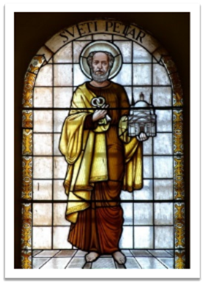
|
|
 The Dictionary of Christian biography states that Simon Peter: “who came to Rome in the days of Claudius Caesar and made such an impression by his magical powers that he was honoured as a god, a statue being erected to him on the Tiber, between the two bridges, bearing the inscription ‘Simoni deo Sancto.’” 32
The Dictionary of Christian biography states that Simon Peter: “who came to Rome in the days of Claudius Caesar and made such an impression by his magical powers that he was honoured as a god, a statue being erected to him on the Tiber, between the two bridges, bearing the inscription ‘Simoni deo Sancto.’” 32
Church historian Adolf Harnack (1851) states that Simon Peter’s main aim was to create a Universal Religion (church). 33
The word Catholic is derived via Latin catholicus, which comes from the Greek word “katholikos” which means Universal. 34
Hasting’s Dictionary of the Apostolic Church (Vol 2 ) states:
“It is more probable that he carried some of the Christian ideas with him and that he wove these into a system of his own. This system did contain some of the germs of later Gnosticism” 35
Harnack also states that Simon Peter: “proclaimed a doctrine in which the Jewish faith was strangely and grotesquely mixed with Babylonian myths, together with some Greek additions.” 33
|
|

This is how Simon Peter (Simon Magus) was inserted into the bible.
There was an apostle of Jesus called Shimeon (Simon) who is called Kaypha. If you see the below verse, the Complete Jewish bible (CJB) translated it into English, keeping the names sounding the same. Shimeon sounds like Shim’on, and kaypha sounds like Kefa. See below verse:
“These are the names of the twelve emissaries: First, Shim‘on, called Kefa, and Andrew his brother, Ya‘akov Ben-Zavdai and Yochanan his brother,” Matthew 10:2 Complete Jewish Bible.
We understand by John 1:42 that the name Kaypha, or Kefa, or Cephas means rock.
Instead of carrying the name over like the complete Jewish Bible did, the other bibles didn’t. The other bibles took the meaning of Kaypha/Kefa which is ‘rock’ and translated into the Greek word for ‘rock’ which is “Petros”, which in English is Peter.
The name “Kaypha” or “Kefa” was translated to “Peter” on purpose to fit this Simon Peter in.
So Shimeon (Simon) Kaypha (or Kefa, Cephas) became Simon Peter, a complete different person.
“Now the names of the twelve apostles are these; The first, Simon, who is called Peter, and Andrew his brother; James the son of Zebedee, and John his brother;” Matthew 10:2 KJV
If this is so, why is Simon the magician’s confrontation with Apostle Peter mentioned in the Acts of the Apostles. This was probably done deliberately so you would not think Simon Peter is Simon the Magician.
Harnack also states “It was a serious mistake of the critics to regard Simon Magus as a fiction.” 33
| Saint Peter was not Peter the disciple of Jesus | <<< Prev | Next >>> | Who wrote the New Testament books? |
